Kelvin Thomson on defending public land (Speech to PPLVic AGM 11 Nov 2017)
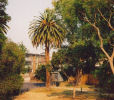 The driving force behind the Protectors of Public Lands, Julianne Bell, passed away on Friday January 27 this year. Julianne was an indefatigable and tireless campaigner for the protection of Melbourne’s public open spaces. She was most well-known as the defender of Royal Park against any and all who would seek to diminish it for their own purposes, and she told me that she was most proud of her role in stopping the East-West Link, a Freeway which would carve up Royal Park in an outrageous act of environmental vandalism. She was the driving force behind this organisation and used it to defend public open spaces far and wide from all manner of threats – the Carlton Gardens, the Catani Gardens, the Exhibition Gardens, the Rogers Memorial Reserve and many others too numerous to mention – no public open space was too far away or too small to merit her attention.
The driving force behind the Protectors of Public Lands, Julianne Bell, passed away on Friday January 27 this year. Julianne was an indefatigable and tireless campaigner for the protection of Melbourne’s public open spaces. She was most well-known as the defender of Royal Park against any and all who would seek to diminish it for their own purposes, and she told me that she was most proud of her role in stopping the East-West Link, a Freeway which would carve up Royal Park in an outrageous act of environmental vandalism. She was the driving force behind this organisation and used it to defend public open spaces far and wide from all manner of threats – the Carlton Gardens, the Catani Gardens, the Exhibition Gardens, the Rogers Memorial Reserve and many others too numerous to mention – no public open space was too far away or too small to merit her attention.
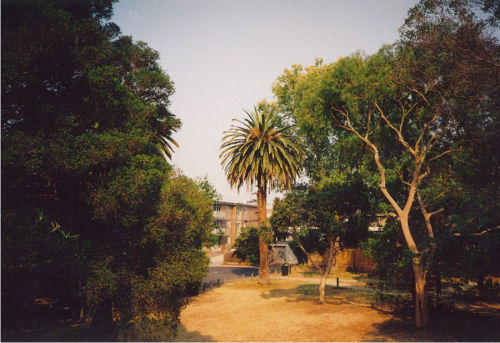
Julianne worked closely with me on the problems caused by Rapid Population growth for the world in general and for Melbourne in particular. She understood that it is people, it is us, who are responsible for environmental damage, and was prepared to cut through the vanity that prevents many of us from acknowledging this. She had worked in the Immigration Department, and told me a number of times about the propensity for migration agents to tell fibs on applications, and the trouble an understaffed Department had in verifying claims and uncovering rorts.
Julianne was not always easy to work with, and she was very hard line. I did think when she was telling me about the evils of the Flower Show in the Exhibition Gardens that perhaps she could lighten up! But she grasped, better I think than anyone else I have ever met, that our public open spaces are constantly in danger from people or organisations or businesses who want to use them for a private benefit, at the cost of the value of the open space asset itself.
She understood and loved the heritage of Marvellous Melbourne, the legacy of beautiful parks and open spaces which Melbourne’s founders bequeathed us, and she was relentless in her defence of them. If Julianne had not been standing guard over them these past decades, they might well look rather different, and Melbourne might well have been on its way to becoming a soulless concrete jungle, like so many other cities around the world.
Over the years various Premiers and Lord Mayors have basked in reflected glory as Melbourne was declared the World’s Most Liveable City. But this title owes, in my view, a fair bit more to Julianne’s work than to theirs. If we are to keep that honour, we will need people to draw inspiration from Julianne, take over her life’s work, and themselves become Protectors of Public Lands.
After Julianne’s death Rose Iser suggested there be a memorial to her in Royal Park. I said I agree. But not too big. Julianne would not approve. I am very pleased that the City of Melbourne has got this right, in its acknowledgment of her at Walmsley House.
The evidence about the physical and mental health benefits of public open space and exposure to nature continues to mount. A study led by The University of Queensland and the ARC Centre of Excellence for Environmental Decisions suggests people might need a minimum dose of nature. The research concludes that people who visit parks for 30 minutes or more each week are much less likely to have high blood pressure or poor mental health than those who don’t.
Researcher Dr. Danielle Shanahan says, “if everyone visited their local parks for half an hour each week there would be 7% fewer cases of depression and 9% fewer cases of high blood pressure”. ”Our children especially benefit from spending more time outdoors. Kids who grow up experiencing natural environments may benefit developmentally and have a heightened awareness as adults than those who don’t”.
The United States Natural Academy of Sciences did a study, reported in February this year, which found that increased urbanisation closely correlates with increased instances of depression and other mental illness. Given this correlation I am astonished that we continue to build high rise towers and continue to encourage people to live in large cities, where traffic congestion, cheek by jowl living and fierce competition for jobs and advancement make us less satisfied and more stressed.
Until our civic leaders and planners come to their senses about this, the Study suggests there is something people can do to help their mental health and wellbeing. They say that getting outdoors and bushwalking, disconnecting from technology and reconnecting with nature, can help. The research indicates that bushwalking can reduce mental fatigue and improve problem solving. Exposing children with ADHD to green outdoor activities reduced their ADHD symptoms significantly. The results suggest that nature exposure can benefit anyone who has a difficult time paying attention or exhibits compulsive behaviour.
Researchers from the University of British Colombia have found memory benefits for women over 70 coming from aerobic exercise. And the Natural Academy of Science researchers found people walking in nature had decreased obsessive or negative thoughts, by a significant margin, whereas people who walked in an urban environment did not. They concluded that bushwalking can lead people away from the negative thoughts that can lead to depression and anxiety.
So we shouldn’t just hang on to our public open space and vegetation for the birds and plants and animals – we should do ourselves a favour and hang on to it for ourselves.
I can’t speak to you about these matters without saying how disappointed I am with the failure of the modern left in politics around the world and environmental groups in particular to come to grips with the real drivers of our twenty-first century failure to successfully tackle inequality and environmental degradation.
The Australian Conservation Foundation has been particularly disappointing. The October edition of their Magazine Habitat sought to do some big picture thinking, with an extensive article titled “The 10 drivers damaging our living world”. It listed what it called “Persistent Human Population Growth” at number 7. While at least it got a mention, the ACF quickly moves on, and there is no action by the ACF to do anything about it.
In fact, rapid population growth is the Number 1 driver of damage to our environment. The article cites as Number 1 “The dominant view of Free Markets, Individualism and Technological Progress”. No doubt this is a real problem, but why is this view dominant in the first place? A key driver of its political success is that around the world the left and environment groups espouse open borders and refuse to talk about population, leaving a massive political vacuum into which populist right figures like Donald Trump. Nigel Farrage, Marine Le Pen etc march. In Queensland at present One Nation is outpolling the Greens.
Coming in at Number 2 in the article is “Undervaluing Nature, including as a result of the increasing disconnection from Nature”. Once again, this is a real problem, but why is it a problem? The answer is increasing urbanisation, and the left and environment groups do little to speak out against increasing urbanisation. Indeed they often support increasing densification – dual occupancies, multi-unit developments, and high rise - claiming, incorrectly, that this is a more efficient and environmentally appropriate way to live.
Coming in at Number 3 in the article is “The Endless Pursuit of Economic Growth through Unrestrained Free Markets”. Again, I agree that this is real problem. But the only reason we really need economic growth is on account of our rapid population growth. If we have population growth, we must have economic growth otherwise we’ll all be manifestly poorer. But if we had a more stable population we could maintain our prosperity without being fixated on economic growth. This is how things used to work, and work they did.
And Number 9 on the list of drivers is “Governments and Market Institutions that Ignore Environmental Degradation”. Once again, true enough. But governments presiding over rapidly growing populations spend most of their time and energy dealing with the problems this creates. It’s all about infrastructure. The present State Government is going hard on the level crossing removal program (which by the way Rosemary West from Green Wedges tells me could damage the Edithvale Wetlands) and on things like the City Link Widening Project. There is a crowding out effect. They don’t have much time to put into saving the Orange-Bellied Parrot. In a stable population Governments would have much more capacity to tackle environmental degradation.
In my view, until the left in general and environmental groups in particular are prepared to call a spade a spade, and stop indulging themselves and the rest of us in this vanity that we have about ourselves as a species – the problem couldn’t possibly be us – then protecting our public lands and open spaces will continue to be a battle.
Now I realise at this point I am in real danger of depressing the crap out of you, and having you go home spend the rest of the year watching TV, instead of inspiring you to get out there and do something. But Julianne Bell did take on, fight and win battles, and I will mention to you two that are going on right now that can be won, and need to be won.
The first is in Fawkner, part of my former electorate of Wills, where VicRoads is the owner of land adjacent to the Merri Creek. For many years they wanted to build a Freeway through there, but strong community campaigns and excellent leadership by their political representatives at the time prevented that.
Now VicRoads want to sell a significant parcel of that land, and Moreland Council is not prepared to pay the price they are asking. This land, as part of the Merri Creek valley, has real environmental and open space value, and should not be sold off for housing. I can assure you that if it were in Balwyn or Camberwell and proposed to be sold off all hell would break loose. Fawkner residents should not be treated as second class citizens, and the land should remain as public open space. Indeed it is adjacent to the former NuFarm Factory, which used to make the chemicals used in Agent Orange. Any housing development on this site will involve dubious clearances from planning and environmental authorities.
I have seen this kind of issue many times over the years, and been involved in the successful resolution of a number of them. It involves the State Government body substantially reducing the money it is seeking, and stop trying to make a financial windfall, and the Council being willing to pay a reduced amount, so that honour is satisfied all round. But it requires a lot of effort to get to this point. Fawkner Residents Association leader Joe Perri is doing a great job trying to prevent this selloff, and I hope some people will be willing to support him in protecting these public lands. His phone number is 0412 112 545, and his email is [email protected].
Of course Julianne Bell knew that our public lands not only need to be protected against people who want to sell them off, but also against those who would appropriate them for a private benefit. This is the issue on the beaches between Port Fairy and Warrnambool, where commercial horse trainers have been licenced to use the beaches of the Belfast Coastal Reserve. This is prime habitat for the endangered Hooded Plover. I find it remarkable that Governments can put a great deal of effort into protecting the Hooded Plover, then undo it all by allowing throughbred racehorses to charge up and down the beach!
The horses churn up the sand, disturb the chicks and adult nesting birds, crush eggs and damage protective fencing. They also risk the safety and enjoyment of joggers, swimmers, surfers, anglers, birdwatchers and other beachgoers. Horses are for courses, not for beaches. The campaign to stop beaches being turned into racetracks is being run by the Victorian National Parks Association, phone 9347 5188 or email [email protected], and by the Belfast Coastal Reserve Action Group, email [email protected]. One of their key people is Killarney resident Shane Howard, lead singer of the Goanna Band.
Thank you for the opportunity to speak with you this afternoon. Julianne Bell would be delighted to see you here carrying on this incredibly important work.

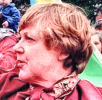 Funeral service Friday, February 3, 2017 at 2pm, St Michael's Church, 220 McPherson St., Princes Hill, 3054. Written by Jill Quirk and Sheila Newman. With the death of Julianne Bell at 5.00 a.m. on Friday, January 27, 2017, environmental activism in Victoria has lost a formidable force and a fearless friend. Julianne was a committed defender of nature and of our right to "keep public land in public hands" through environmental groups such as the Royal Park Protection Group and Protectors of Public Lands, Victoria (which she founded). She sternly opposed the encroachment of development on public land, such as the Commonwealth Games Village (a real-estate development which took a large slice of Royal Park and for which 2000 trees were removed). For Julianne her best achievement was the prevention of the construction of the East-West Link, which would have shot through Royal Park in a protracted construction period and gouged a permanent scar. Whilst Julianne by no means did this single handed, her relentless efforts over weeks and months were undoubtedly essential to the eventual victory.
Funeral service Friday, February 3, 2017 at 2pm, St Michael's Church, 220 McPherson St., Princes Hill, 3054. Written by Jill Quirk and Sheila Newman. With the death of Julianne Bell at 5.00 a.m. on Friday, January 27, 2017, environmental activism in Victoria has lost a formidable force and a fearless friend. Julianne was a committed defender of nature and of our right to "keep public land in public hands" through environmental groups such as the Royal Park Protection Group and Protectors of Public Lands, Victoria (which she founded). She sternly opposed the encroachment of development on public land, such as the Commonwealth Games Village (a real-estate development which took a large slice of Royal Park and for which 2000 trees were removed). For Julianne her best achievement was the prevention of the construction of the East-West Link, which would have shot through Royal Park in a protracted construction period and gouged a permanent scar. Whilst Julianne by no means did this single handed, her relentless efforts over weeks and months were undoubtedly essential to the eventual victory. 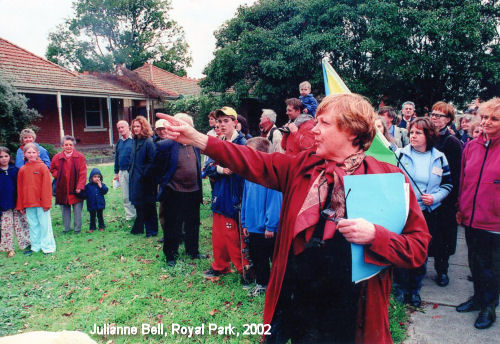
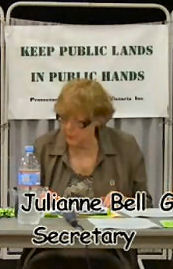
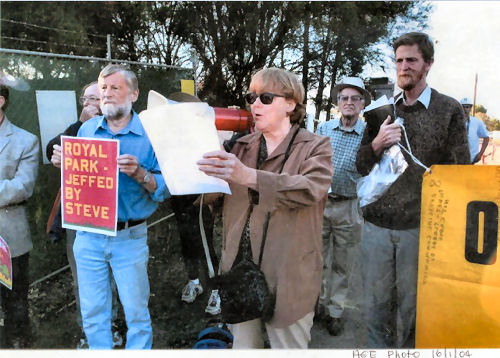
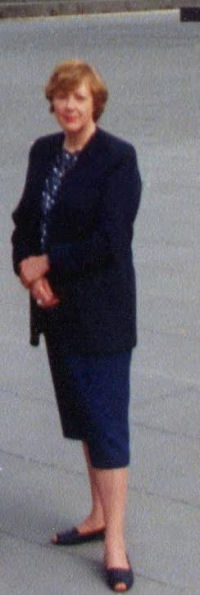
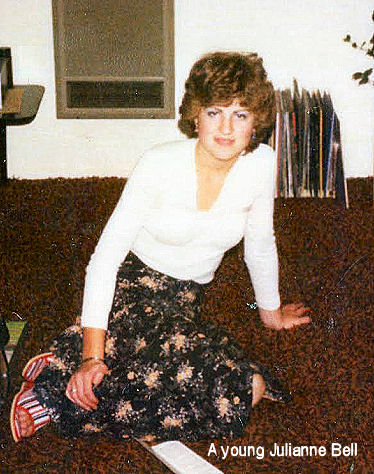


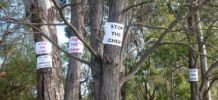 Greens Councillors Amanda Stone, Sam Gaylard and Misha Coleman voted together with Councillors Stephen Jolly and Jackie Fristacky to give the go ahead to run a cycle path through a natural reserve. Trees will be felled. This was not a foregone result, since the decision was carried only by one in a 5:4 vote. The Greens obviously had a choice, but seem to have chosen to put transport ahead of nature in a very overcrowded area with little access to natural surroundings. This lack of interest in protecting the natural world and our access to it from overdevelopment seems to be an increasing feature of the Greens, particularly to the North of the Yarra.
Greens Councillors Amanda Stone, Sam Gaylard and Misha Coleman voted together with Councillors Stephen Jolly and Jackie Fristacky to give the go ahead to run a cycle path through a natural reserve. Trees will be felled. This was not a foregone result, since the decision was carried only by one in a 5:4 vote. The Greens obviously had a choice, but seem to have chosen to put transport ahead of nature in a very overcrowded area with little access to natural surroundings. This lack of interest in protecting the natural world and our access to it from overdevelopment seems to be an increasing feature of the Greens, particularly to the North of the Yarra. 

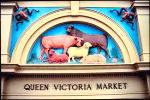 "The redevelopment and remodelling of the Queen Victoria Market (QVM) plus changes in its functions proposed by the City of Melbourne, led by the Lord Mayor Robert Doyle, should be ringing alarm bells amongst Melburnians. This is one of the biggest assaults ever mounted on the QVM in the history of Melbourne." (Julianne Bell, Protectors of Public Lands Victoria Inc.)
"The redevelopment and remodelling of the Queen Victoria Market (QVM) plus changes in its functions proposed by the City of Melbourne, led by the Lord Mayor Robert Doyle, should be ringing alarm bells amongst Melburnians. This is one of the biggest assaults ever mounted on the QVM in the history of Melbourne." (Julianne Bell, Protectors of Public Lands Victoria Inc.)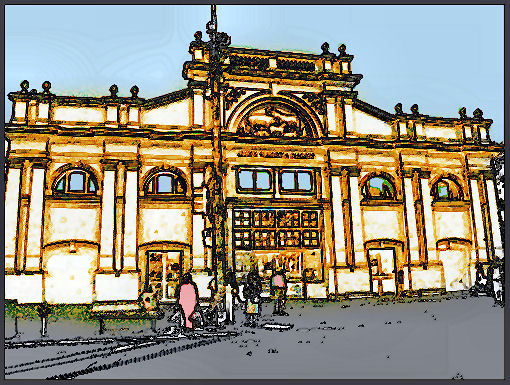
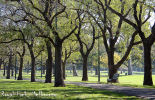 This is a report on Transurban and the Western Distributor and the Defence of Our Parks from Commercial Development and Takeover by Park Furniture. It also contains details of upcoming Transurban: Western Distributor - Information sessions through the inner west in May and June.
This is a report on Transurban and the Western Distributor and the Defence of Our Parks from Commercial Development and Takeover by Park Furniture. It also contains details of upcoming Transurban: Western Distributor - Information sessions through the inner west in May and June.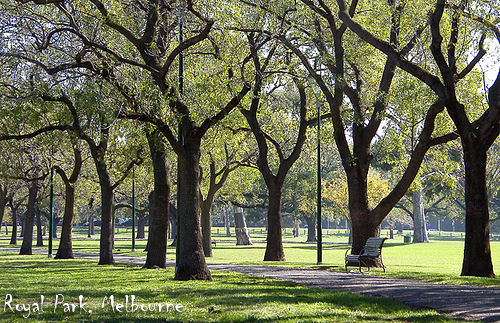
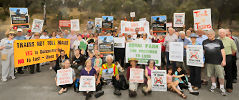 It is believed that up until two weeks post election 457 visa workers from Spain and their families were still arriving to work on East West Link. However the latest news is that the Authority behind the East West Link is being disbanded by the Andrews Government. There are, however, still many issues left over from the Napthine Government and East West Link that need to be carefully monitored in the area of environment, democracy and heritage.
It is believed that up until two weeks post election 457 visa workers from Spain and their families were still arriving to work on East West Link. However the latest news is that the Authority behind the East West Link is being disbanded by the Andrews Government. There are, however, still many issues left over from the Napthine Government and East West Link that need to be carefully monitored in the area of environment, democracy and heritage.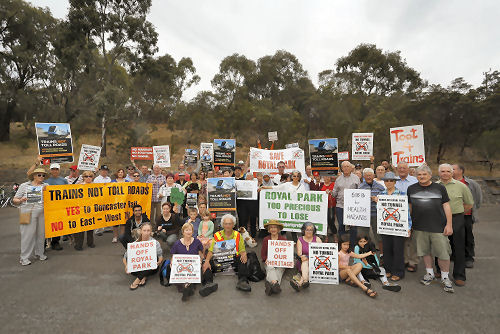 East West Link News: The good news received yesterday is that Linking Melbourne Authority responsible for the East West Link is being disbanded by the Andrews Government."Authority behind the East West Link ditched" by Clay Lucas. http://www.theage.com.au/victoria/authority-behind-east-west-link-ditched-20150107-12jg0e.html
East West Link News: The good news received yesterday is that Linking Melbourne Authority responsible for the East West Link is being disbanded by the Andrews Government."Authority behind the East West Link ditched" by Clay Lucas. http://www.theage.com.au/victoria/authority-behind-east-west-link-ditched-20150107-12jg0e.html 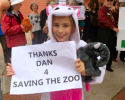 This article thanks all who attended the celebration today (7 December 2014) to give thanks to the incoming Labor Government and to all who have campaigned for years to save Royal Park and the Zoo from certain destruction should the East West Link be constructed. The article also contains a photo of a concerning note left by East West Connect for a resident, requesting some kind of ongoing involvement in the link.
This article thanks all who attended the celebration today (7 December 2014) to give thanks to the incoming Labor Government and to all who have campaigned for years to save Royal Park and the Zoo from certain destruction should the East West Link be constructed. The article also contains a photo of a concerning note left by East West Connect for a resident, requesting some kind of ongoing involvement in the link.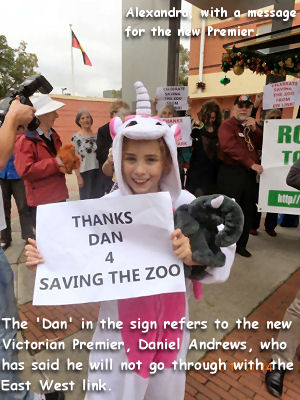 Note the photo of a child, Alexandra, dressed as a unicorn holding a wombat with the message : "Thanks Dan 4 Saving the Zoo"
Note the photo of a child, Alexandra, dressed as a unicorn holding a wombat with the message : "Thanks Dan 4 Saving the Zoo"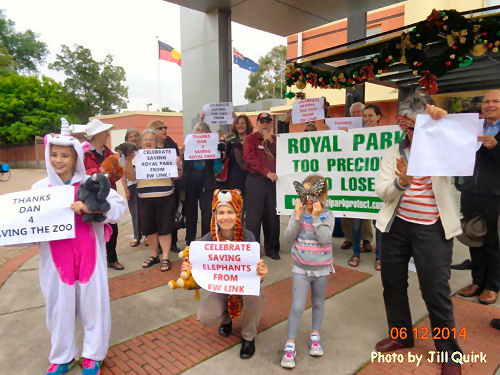
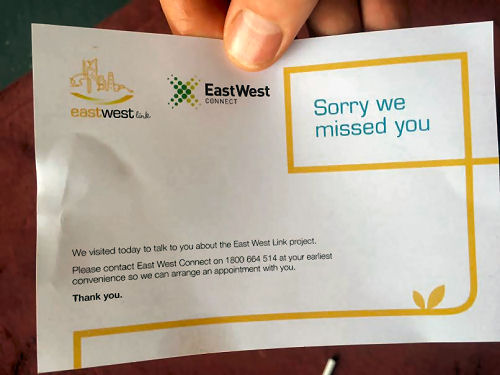
 Inside see copy of the letter from a lawyer which was today delivered to East West Connect, Linking Melbourne authority and Lend Lease, on behalf of Protectors of Public Lands Victoria Inc and Royal Park Protection Group Inc.. advising that work on the Link is no longer justified. This article extends an invitation to celebrate the end of East West Link and documents the cessation of work on this loathed piece of infrastructure. So many people worked so hard to stop this abomination, spent so much time and their own money. Many thought they could never win. Even the judicial system seemed aligned with the government against the people. Julianne Bell and others who followed her example have truly earned this extraordinary outcome, which certainly contributed to the undoing of the Napthine Government.
Inside see copy of the letter from a lawyer which was today delivered to East West Connect, Linking Melbourne authority and Lend Lease, on behalf of Protectors of Public Lands Victoria Inc and Royal Park Protection Group Inc.. advising that work on the Link is no longer justified. This article extends an invitation to celebrate the end of East West Link and documents the cessation of work on this loathed piece of infrastructure. So many people worked so hard to stop this abomination, spent so much time and their own money. Many thought they could never win. Even the judicial system seemed aligned with the government against the people. Julianne Bell and others who followed her example have truly earned this extraordinary outcome, which certainly contributed to the undoing of the Napthine Government.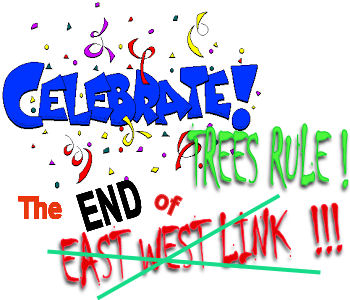 Work Started in Royal Park on East West Link by East West Connect Consortium Prior to Election
Work Started in Royal Park on East West Link by East West Connect Consortium Prior to Election 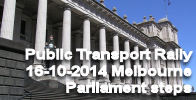 Protectors of Public Lands Victoria has issued an invitation to concerned Victorians to attend a short but concentrated rally scheduled for 12:45 pm for a 1 pm start to 2 pm on Thursday 16 October 2014 on the steps of Parliament in Spring Street.
Protectors of Public Lands Victoria has issued an invitation to concerned Victorians to attend a short but concentrated rally scheduled for 12:45 pm for a 1 pm start to 2 pm on Thursday 16 October 2014 on the steps of Parliament in Spring Street.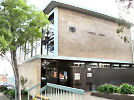 Julianne Bell of Protectors of Public Land Victoria will be the speaker at a meeting of concerned citizens "Protecting Heritage and Public Interest in Banyule," Sunday July 6th, 2.00pm for 2.30pm, Seddon St. Community Centre, Ivanhoe. Ivanhoe Civic Precinct Master Plan includes demolition of the current library and privatisation of three lots of civic land. You can attend the meeting and be listed to speak at the start of the meeting.
Julianne Bell of Protectors of Public Land Victoria will be the speaker at a meeting of concerned citizens "Protecting Heritage and Public Interest in Banyule," Sunday July 6th, 2.00pm for 2.30pm, Seddon St. Community Centre, Ivanhoe. Ivanhoe Civic Precinct Master Plan includes demolition of the current library and privatisation of three lots of civic land. You can attend the meeting and be listed to speak at the start of the meeting.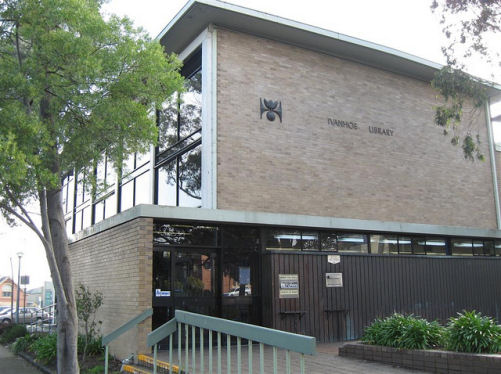 Ivanhoe Civic Precinct Master Plan includes demolition of the current, iconic, ‘mid-century modernist’ design Library and privatisation of three lots of civic land!
Ivanhoe Civic Precinct Master Plan includes demolition of the current, iconic, ‘mid-century modernist’ design Library and privatisation of three lots of civic land! The admirable tenacity and personal sacrifices of people involved over a long time in fighting the East West Link on the streets and in the courts have finally effected some changes, but the fat lady has not sung yet. The huge Elliott Avenue toll road exchange that threatened the viability of Melbourne Zoo, will not go ahead. Royal Park woodlands near the zoo will also be left standing. What will happen instead is not yet clear and no-one can relax. The East West Link, if it goes ahead in any form, will be a kind of cut-off point for environment and democracy in Melbourne. The huge efforts already expended by the public should have seen the toll way cancelled and forgotten That it survives in some form draws attention to the tragic influence of the growth lobby over our laws and government. (Candobetter.net editorial)
The admirable tenacity and personal sacrifices of people involved over a long time in fighting the East West Link on the streets and in the courts have finally effected some changes, but the fat lady has not sung yet. The huge Elliott Avenue toll road exchange that threatened the viability of Melbourne Zoo, will not go ahead. Royal Park woodlands near the zoo will also be left standing. What will happen instead is not yet clear and no-one can relax. The East West Link, if it goes ahead in any form, will be a kind of cut-off point for environment and democracy in Melbourne. The huge efforts already expended by the public should have seen the toll way cancelled and forgotten That it survives in some form draws attention to the tragic influence of the growth lobby over our laws and government. (Candobetter.net editorial) On 30 June 2014, the Minister for Planning, the Hon. Matthew Guy MLA, issued a press release approving the controversial East West Link Toll Road eastern section. (EW Link)
On 30 June 2014, the Minister for Planning, the Hon. Matthew Guy MLA, issued a press release approving the controversial East West Link Toll Road eastern section. (EW Link) 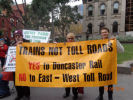 Congratulations to all who organised, prepared, worked for and took part in the rally yesterday Saturday 28 June . It was a monumental task and a great celebration of community spirit. What was so impressive was the amazing diversity of groups and spread of ages of marchers and participants.
Congratulations to all who organised, prepared, worked for and took part in the rally yesterday Saturday 28 June . It was a monumental task and a great celebration of community spirit. What was so impressive was the amazing diversity of groups and spread of ages of marchers and participants.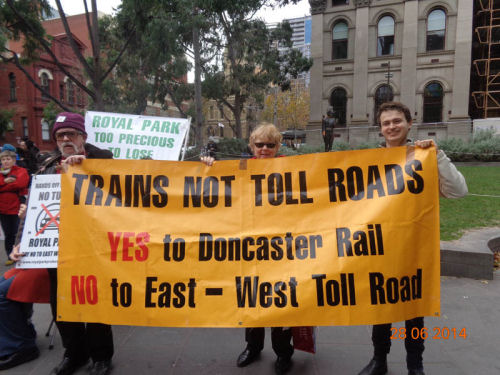 One leader of a community group who has been to lots of protests speaks for many when she commented yesterday after the march in an email:
One leader of a community group who has been to lots of protests speaks for many when she commented yesterday after the march in an email: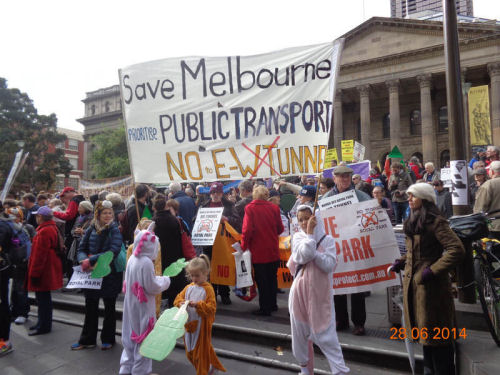
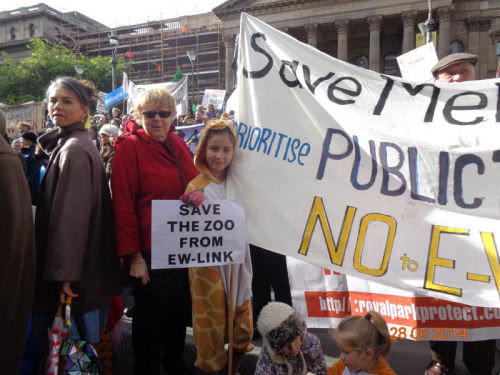
 Tomorrow, Saturday 28 June 2014, thousands are expected to pour onto the streets to take a final stand against the monstrous $14 billion East West Link (EW Link) project about to be foisted on the long suffering people of Victoria by - in our view - the incompetent and increasingly unpopular Napthine Government. Demands of the rally are: scrap the E W Link Toll Road; rip up the contracts if/when signed; and invest in public transport.
Tomorrow, Saturday 28 June 2014, thousands are expected to pour onto the streets to take a final stand against the monstrous $14 billion East West Link (EW Link) project about to be foisted on the long suffering people of Victoria by - in our view - the incompetent and increasingly unpopular Napthine Government. Demands of the rally are: scrap the E W Link Toll Road; rip up the contracts if/when signed; and invest in public transport. Additionally the call has gone out for the Coalition to make the EW Link an election issue and to resist signing contracts before “the people” have spoken. Protestors will rally outside The State Library at the corner of Swanston and Latrobe Streets by 1 pm tomorrow, hear speeches and then march to Flinders Street Station.
Additionally the call has gone out for the Coalition to make the EW Link an election issue and to resist signing contracts before “the people” have spoken. Protestors will rally outside The State Library at the corner of Swanston and Latrobe Streets by 1 pm tomorrow, hear speeches and then march to Flinders Street Station.
 When: 2 pm for a 2:15 pm start on Saturday 10 May 2014
When: 2 pm for a 2:15 pm start on Saturday 10 May 2014
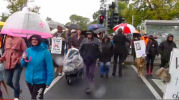
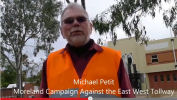 Led by Rod Quantock and organised by Moreland Community Against the Tollway, the Children's March for the Animals drew a concerned crowd despite the pouring rain, to raise awareness of the serious threat the East-West tollway poses to the Melbourne Zoo. It is proposed to be built at around 40 metres from the zoo wall (pictured below the video).
Led by Rod Quantock and organised by Moreland Community Against the Tollway, the Children's March for the Animals drew a concerned crowd despite the pouring rain, to raise awareness of the serious threat the East-West tollway poses to the Melbourne Zoo. It is proposed to be built at around 40 metres from the zoo wall (pictured below the video).
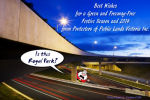 Protectors of Public Land Victoria Inc. wish their friends a Freeway Free Christmas. For this they need your support. They need your financial support. Seriously, this is serious. Their battle is ours and yours, but it needs funding. See inside for more detail.
Protectors of Public Land Victoria Inc. wish their friends a Freeway Free Christmas. For this they need your support. They need your financial support. Seriously, this is serious. Their battle is ours and yours, but it needs funding. See inside for more detail. Card by Rod Binnington
Card by Rod Binnington Chair of the
Chair of the  The event took place today on Melbourne's Parliament House steps at 12 noon. Master of ceremonies, Rod Quantock introduced the main speakers - Jackie Fristacky, Mayor of Yarra, Jan Chantry, Mayor of Moonee Ponds, Tony Morton, president Public Transport Users' Association, Richard Foster, Melbourne City councillor, Greg Barber, Leader , Greens Party Victoria MP, Richard Wynne Shadow Minister for Public Transport , Brian Tee, Shadow Minister for Planning , Joe Edwards,West Parkville resident, Keith Fitzgerald, Collingwood resident. Members of community groups announced future events regarding the East West Link campaign.
The event took place today on Melbourne's Parliament House steps at 12 noon. Master of ceremonies, Rod Quantock introduced the main speakers - Jackie Fristacky, Mayor of Yarra, Jan Chantry, Mayor of Moonee Ponds, Tony Morton, president Public Transport Users' Association, Richard Foster, Melbourne City councillor, Greg Barber, Leader , Greens Party Victoria MP, Richard Wynne Shadow Minister for Public Transport , Brian Tee, Shadow Minister for Planning , Joe Edwards,West Parkville resident, Keith Fitzgerald, Collingwood resident. Members of community groups announced future events regarding the East West Link campaign. 


 See update and details at
See update and details at  The East-West Link (EW Link) Preliminary Assessment by Geoff Lawler, Director of City Planning and Infrastructure, spells out in graphic terms to Council the wide scale damage to Royal Park likely from the EW Link. It is, therefore, difficult to understand why the City of Melbourne Mayor and Councillors have not apprehended the significance of this report and voted to publically oppose the destruction of the City by the East West Link. Submission from Protectors of Public Lands Victoria Inc. (PPL VIC)
The East-West Link (EW Link) Preliminary Assessment by Geoff Lawler, Director of City Planning and Infrastructure, spells out in graphic terms to Council the wide scale damage to Royal Park likely from the EW Link. It is, therefore, difficult to understand why the City of Melbourne Mayor and Councillors have not apprehended the significance of this report and voted to publically oppose the destruction of the City by the East West Link. Submission from Protectors of Public Lands Victoria Inc. (PPL VIC) 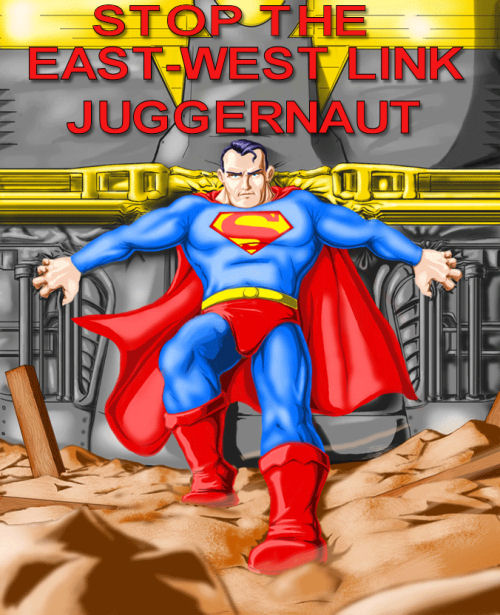 When a vote was taken recently on whether approval would be given for the exploratory drilling in Royal Park, Councillor Stephen Mayne voted for it to proceed saying that there was time for a decision to be made in the future concerning the dangers of the EW Link. Hence Councillors voted for the drilling – and the project – to proceed. (6 to 5.) DDAY has arrived and the City of Melbourne must now take a stand against the EW Link. It is disappointing that the City of Melbourne has not taken a stand earlier whereas the following municipalities have voted to say “no” to the East West Link: Darebin, Glen Eira, Moonee Valley, Moreland and Yarra.
When a vote was taken recently on whether approval would be given for the exploratory drilling in Royal Park, Councillor Stephen Mayne voted for it to proceed saying that there was time for a decision to be made in the future concerning the dangers of the EW Link. Hence Councillors voted for the drilling – and the project – to proceed. (6 to 5.) DDAY has arrived and the City of Melbourne must now take a stand against the EW Link. It is disappointing that the City of Melbourne has not taken a stand earlier whereas the following municipalities have voted to say “no” to the East West Link: Darebin, Glen Eira, Moonee Valley, Moreland and Yarra.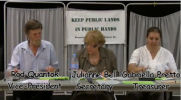
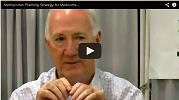 "I am just amazed at the breadth and the depth of interest and knowledge about planning in groups like this, so I don't understand - given that - how the government gets away with what it does."(Prof. Michael Buxton)
"I am just amazed at the breadth and the depth of interest and knowledge about planning in groups like this, so I don't understand - given that - how the government gets away with what it does."(Prof. Michael Buxton)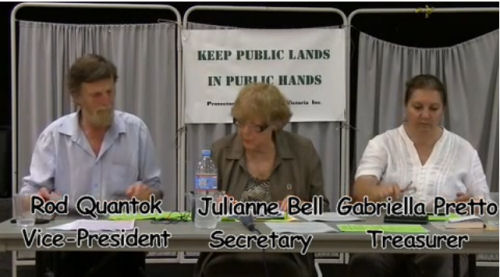
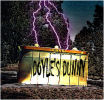 You are invited to the official opening, the inauguration, of "Doyle's Dunny", a new toilet block at the entrance of the Australian Native Garden in Royal Park, Parkville. Iconic vegetation and indigenous and Melbourne Gardens traditions have been set aside for the siting of this enormous new stainless steel super toilet. The inauguration will be officiated by Rod Quantock Acting President of PPL VIC, as MC. Venue is Gatehouse Street Parkville entrance to Australian Native Garden, Royal Park, at 12:30 pm Friday 15 February 2013.
You are invited to the official opening, the inauguration, of "Doyle's Dunny", a new toilet block at the entrance of the Australian Native Garden in Royal Park, Parkville. Iconic vegetation and indigenous and Melbourne Gardens traditions have been set aside for the siting of this enormous new stainless steel super toilet. The inauguration will be officiated by Rod Quantock Acting President of PPL VIC, as MC. Venue is Gatehouse Street Parkville entrance to Australian Native Garden, Royal Park, at 12:30 pm Friday 15 February 2013. PPL VIC: Official Opening of "Doyle's Dunny" Entrance to the Australian Native Garden Royal Park on Gatehouse Street Parkville at 12:30 pm Friday 15 February 2013 You are invited to the official opening, the inauguration, of "Doyle's Dunny", a new toilet block at the entrance of the Australian Native Garden in Royal Park, Parkville.
PPL VIC: Official Opening of "Doyle's Dunny" Entrance to the Australian Native Garden Royal Park on Gatehouse Street Parkville at 12:30 pm Friday 15 February 2013 You are invited to the official opening, the inauguration, of "Doyle's Dunny", a new toilet block at the entrance of the Australian Native Garden in Royal Park, Parkville. 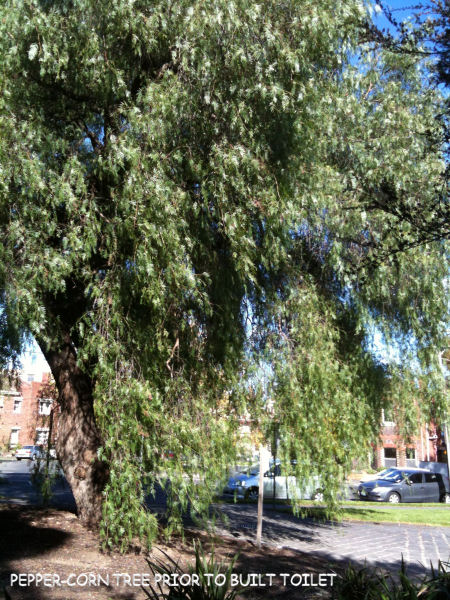 (It is believed this tree was planted by Francis Meaker the first Park Ranger and Bailiff sometime in the late 19 th century.) The Royal Park Master Plan which recommended a stand of lemon scented gums at this entrance of Royal Park, not a toilet block, has been ignored. The Council has a new policy re toilet blocks and has discarded the old cast iron model, painted Brunswick Green to fit in with the heritage streetscapes and Gardens. Instead we have a stainless steel up to date model. Note that the area behind the toilet block has been cleared to stop any "anti social behavior", to use the Council staff's euphemism.
(It is believed this tree was planted by Francis Meaker the first Park Ranger and Bailiff sometime in the late 19 th century.) The Royal Park Master Plan which recommended a stand of lemon scented gums at this entrance of Royal Park, not a toilet block, has been ignored. The Council has a new policy re toilet blocks and has discarded the old cast iron model, painted Brunswick Green to fit in with the heritage streetscapes and Gardens. Instead we have a stainless steel up to date model. Note that the area behind the toilet block has been cleared to stop any "anti social behavior", to use the Council staff's euphemism.  This model and location were apparently given a blessing by the President of the Parkville Association and the Branch Chair of the Australian Garden History Society. Unkind opponents have nicknamed the edifice the "Silver Tomb" and have referred to it as the "biggest blot on the landscape in Melbourne".
This model and location were apparently given a blessing by the President of the Parkville Association and the Branch Chair of the Australian Garden History Society. Unkind opponents have nicknamed the edifice the "Silver Tomb" and have referred to it as the "biggest blot on the landscape in Melbourne".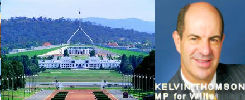 Julianne Bell (Protectors of Public Land Victoria) and Jill Quirk (Sustainable Population Australia (SPA) Victoria and Tasmanian Branches) met with Kelvin Thomson last week for advice on contacting Federal Election candidates regarding population and urban planning. They are very pleased to see that he has been appointed Parliamentary Secretary for Trade.
Julianne Bell (Protectors of Public Land Victoria) and Jill Quirk (Sustainable Population Australia (SPA) Victoria and Tasmanian Branches) met with Kelvin Thomson last week for advice on contacting Federal Election candidates regarding population and urban planning. They are very pleased to see that he has been appointed Parliamentary Secretary for Trade.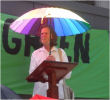 Not so livable Victoria - Melbourne rally calls on government to curb immigration and stop advertising for new settlers overseas for Victoria in view of environmental and amenity impacts of huge population
Not so livable Victoria - Melbourne rally calls on government to curb immigration and stop advertising for new settlers overseas for Victoria in view of environmental and amenity impacts of huge population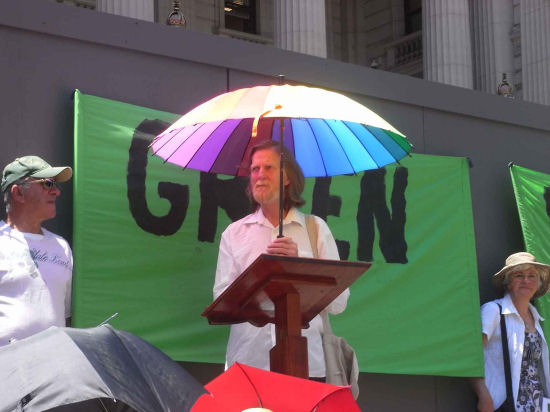
 The consideration of the Planning Zones Review should have been referred to the Parliamentary Committee for Environment and Planning which has considerable resources to put the 2,000 submissions on the Parliamentary website and then record on Hansard the hearings of some of the submitters before the Parliamentary Committee.
The consideration of the Planning Zones Review should have been referred to the Parliamentary Committee for Environment and Planning which has considerable resources to put the 2,000 submissions on the Parliamentary website and then record on Hansard the hearings of some of the submitters before the Parliamentary Committee.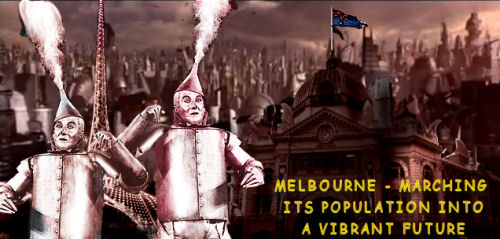

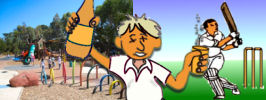 Hays Paddock, created in 1980, is an open woodland park with wetlands forming part of the Yarra River wildlife corridor. An iconic feature is the children’s discovery playground catering for disabled kids, attracting visitors from all over the metropolitan area. Sports players form only a small percentage of users. The community is alarmed that alcohol will be sold and drinking allowed until late at night on the pavilion verandas. The excuse is to fund the Cricket Club activities, but Hays Paddock is not a business precinct and recent photographs of nude and partially clothed male cricketers there suggest that the Club is not fit to have a liquor licence anywayHearing is scheduled for 9:30 am tomorrow Monday 12 November 2012 at the VCGLR Office, 49 Elizabeth Street Richmond. Melways Map Reference 2 G H2
Hays Paddock, created in 1980, is an open woodland park with wetlands forming part of the Yarra River wildlife corridor. An iconic feature is the children’s discovery playground catering for disabled kids, attracting visitors from all over the metropolitan area. Sports players form only a small percentage of users. The community is alarmed that alcohol will be sold and drinking allowed until late at night on the pavilion verandas. The excuse is to fund the Cricket Club activities, but Hays Paddock is not a business precinct and recent photographs of nude and partially clothed male cricketers there suggest that the Club is not fit to have a liquor licence anywayHearing is scheduled for 9:30 am tomorrow Monday 12 November 2012 at the VCGLR Office, 49 Elizabeth Street Richmond. Melways Map Reference 2 G H2
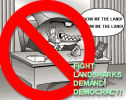 In her submission to the Victorian State Department of Planning and Community Services, Julianne Bell, Secretary of
In her submission to the Victorian State Department of Planning and Community Services, Julianne Bell, Secretary of 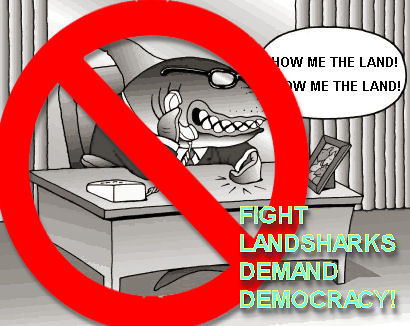
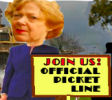 Despite the fact there are no publicly available plans for this project, Stage One of construction of the East West Link has already commenced with "geological investigation" (i.e. drilling for soil and rock samples and testing for underground water) along the proposed alignment of the above/under/on ground road way. As spelt out in the Eddington Review of 2008 the freeway/tollway is likely to be open cut through Royal Park. It seems that there has been a total failure to responsibly and democratically consult the Victorian Public on their wishes in this matter as it affects public lands. The snap protest will be held near the reserve with the drilling rig at the corner of Neill and Canning Streets Carlton outside the Dan O’Connell Hotel starting at 12:30 pm. (Melways Map Reference 2BK4).
Despite the fact there are no publicly available plans for this project, Stage One of construction of the East West Link has already commenced with "geological investigation" (i.e. drilling for soil and rock samples and testing for underground water) along the proposed alignment of the above/under/on ground road way. As spelt out in the Eddington Review of 2008 the freeway/tollway is likely to be open cut through Royal Park. It seems that there has been a total failure to responsibly and democratically consult the Victorian Public on their wishes in this matter as it affects public lands. The snap protest will be held near the reserve with the drilling rig at the corner of Neill and Canning Streets Carlton outside the Dan O’Connell Hotel starting at 12:30 pm. (Melways Map Reference 2BK4). 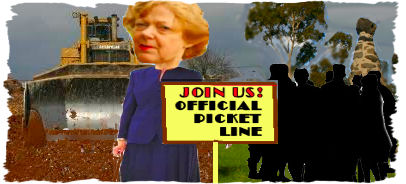
 Threats to Royal Park: East West link, Children's Hospital expansion onto public land under Royal Children’s Hospital (Land) Act 2007, large new obtrusive metal public toilet known as "Doyle's dunny" after the Lord Mayor prioritised its installation. Meaningful community events planned to combat proposed outrages. Turn up to meet an energetic and politicised crew of public land activists with a taste for local environment and democracy.
Threats to Royal Park: East West link, Children's Hospital expansion onto public land under Royal Children’s Hospital (Land) Act 2007, large new obtrusive metal public toilet known as "Doyle's dunny" after the Lord Mayor prioritised its installation. Meaningful community events planned to combat proposed outrages. Turn up to meet an energetic and politicised crew of public land activists with a taste for local environment and democracy.
Recent comments